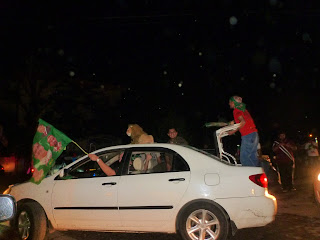PML-N won last night, which is kind of a bummer (not that I particularly love Imran Khan or Zardari, but Nawaz Sharif, really?). Then I went out into the balcony garden this morning and noticed some disconcerting things were happening on my own turf as well.
The bean plants are dying, I think from poor drainage. I stopped giving them water a few days ago and the soil is still moist to the touch, which is crazy because it's so damn hot and sunny outside. Maybe I will try to repot them...but they might be too far gone. Then there is the issue that my vines are producing flowers but they all just wither and die. Why am I not getting any fruits, with the exception of one little bitter melon? It could be any number of things...poor soil, too hot, not enough room for root growth, or maybe I need to water twice a day instead of just once? I repotted my celery and parsley because they weren't growing very well at all, and they seemed to wilt really quickly, so hopefully mixing more compost and a bit of coconut husk into the soil will help the moisture remain more consistent. I also moved my parsley into a sunnier spot which may be a gamble but it's barely grown since I repotted it the first time over a month ago. I'll just have to be extra diligent with water there as well.
Then there are the herbs. The basil is doing well and seems to be flourishing since I repotted it. The oregano is coming along slowly but surely. But the rosemary...whatever seeds I planted from the packet of "rosemary" seeds germinated like crazy and are growing well, but they are definitely not rosemary. It's a plant that looks sort of like flat leaf parsley, but I can't really tell what it is. Sort of a disappointment, I had high hopes for the culinary possibilities that a bunch of fresh rosemary would offer. At some point I'll post a picture and maybe someone can help me identify the mystery sprouts.
With all of this in mind, I think it's time for a consultation with the mali; the next day that he comes I'll make sure to catch him and get his advice!
The bean plants are dying, I think from poor drainage. I stopped giving them water a few days ago and the soil is still moist to the touch, which is crazy because it's so damn hot and sunny outside. Maybe I will try to repot them...but they might be too far gone. Then there is the issue that my vines are producing flowers but they all just wither and die. Why am I not getting any fruits, with the exception of one little bitter melon? It could be any number of things...poor soil, too hot, not enough room for root growth, or maybe I need to water twice a day instead of just once? I repotted my celery and parsley because they weren't growing very well at all, and they seemed to wilt really quickly, so hopefully mixing more compost and a bit of coconut husk into the soil will help the moisture remain more consistent. I also moved my parsley into a sunnier spot which may be a gamble but it's barely grown since I repotted it the first time over a month ago. I'll just have to be extra diligent with water there as well.
Then there are the herbs. The basil is doing well and seems to be flourishing since I repotted it. The oregano is coming along slowly but surely. But the rosemary...whatever seeds I planted from the packet of "rosemary" seeds germinated like crazy and are growing well, but they are definitely not rosemary. It's a plant that looks sort of like flat leaf parsley, but I can't really tell what it is. Sort of a disappointment, I had high hopes for the culinary possibilities that a bunch of fresh rosemary would offer. At some point I'll post a picture and maybe someone can help me identify the mystery sprouts.
With all of this in mind, I think it's time for a consultation with the mali; the next day that he comes I'll make sure to catch him and get his advice!

























